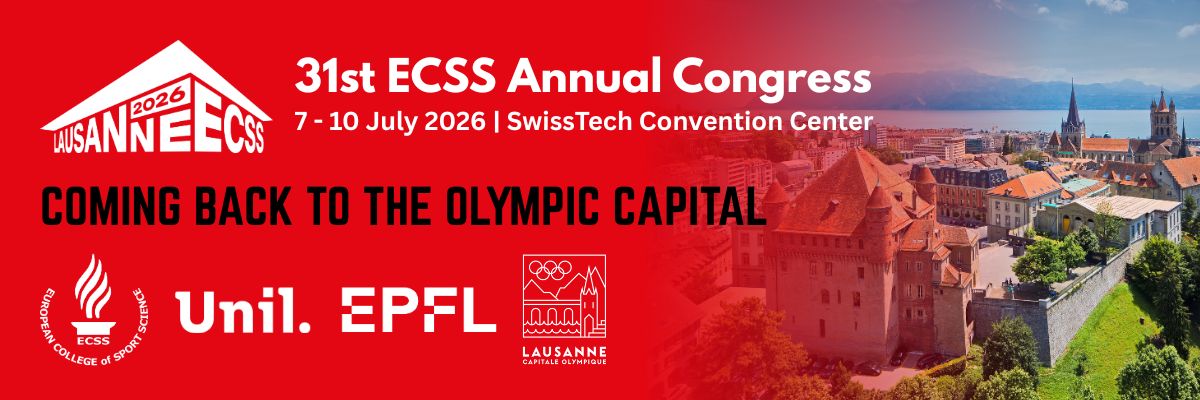Scientific Programme
Sports and Exercise Medicine and Health
IS-MH11 - When Biology Meets Behaviour: Integrating lifestyle and pharmacotherapy in obesity and chronic disease management.
Date: 09.07.2026, Time: 17:00 - 18:15, Session Room: Auditorium C (STCC)
Description
Incretin-based pharmacotherapies have rapidly reshaped the management of obesity and type 2 diabetes by inducing profound weight loss and improving glycometabolic control. In contrast to other drugs targeting chronic disease modulation (e.g., statins, ACEI), incretin agonists achieve their effects at least partly through appetite regulation and behaviour modification. At the same time, it is now recognised that the distribution of incretin receptors is ubiquitous, and beneficial pleitropic effects are emerging alongside new challenges, such reductions in lean mass, altered energy availability, appropriate nutrition in the context of appetite suppression, and shifts in physical activity. The impacts of drug cycling and the biological implications of deprescribing are also germane. Acknowledging the rapid, enthusiastic and largely unregulated acceleration in the use of incretin agonists, this symposium will use a combination of randomised controlled trial evidence, case insights, and consumer perspectives to describe how the benefits of these new pharmacotherapies can be combined with personalised lifestyle interventions to optimise chronic disease prevention and prolong human healthspan.
Chair(s)

Craig Sale
Manchester Metropolitan University, Institute of Sport
United Kingdom

Speaker A
Renee Rogers
The University of Kansas, The University of Kansas Medical Centre
United States
Read CVECSS Lausanne 2026: IS-MH11 [41451]
Training on Empty: lived experiences of trying to exercise when using obesity treatment medications
Incretin-based obesity pharmacotherapies are transforming clinical outcomes, yet many patients describe new challenges when attempting to engage in structured exercise while using these agents. Emerging evidence and growing narratives highlight a critical gap: the biological and behavioral realities of “training on empty.” Appetite suppression, reduced energy intake, fatigue, nausea, and timing-dependent fluctuations in gastrointestinal side effects can directly influence exercise readiness, perceived exertion, and day-to-day motivation. These biological responses intersect with behavioral drivers of adherence, including confidence, perceived capability, and previous exercise experiences. This presentation will combine qualitative research with real-case data from a clinical trial in adults living with obesity who participated in aerobic and resistance training while using obesity treatment medications. Data from patients with obesity and other co-conditions will demonstrate unique considerations for exercise training and how body size, low energy availability, weight loss, and medication-related fluctuations impact progression, training volume, and the ability to meet traditional exercise targets. Participants often struggled with gradual load increases, maintaining weekly training frequency, and tolerating higher-intensity sessions without session-specific modification. Together, these lived experiences and real-world observations reveal an urgent need for coordinated care models that pair pharmacotherapy with skilled, patient-centered movement guidance. Effective support requires integrating biological insight, such as timing training around medication effects and identifying fueling strategies within appetite suppression and helping patients let go of previous diet and exercise training patterns, within a behavioral framework that respect autonomy, lived experience, and sustainable habit formation. This talk will outline practical strategies for interdisciplinary collaboration among obesity clinicians, nutrition, and exercise professionals. By aligning communication and reframing movement as a supportive and flexible tool rather than a prescriptive mandate, care teams may help patients build confidence, enhance muscle and cardiometabolic health, and develop a positive and lasting relationship with exercise while using obesity medications.

Speaker B
Craig Sale
Manchester Metropolitan University, Institute of Sport
United Kingdom
Read CVECSS Lausanne 2026: IS-MH11 [6637]
Optimising Metabolism and Safeguarding Musculoskeletal Tissue: potential nutritional supplementation approaches during rapid weight loss
Incretin-based pharmacotherapies, including GLP-1 receptor agonists and dual- or multi-agonists, are rapidly reshaping the management of obesity and type 2 diabetes by facilitating significant weight loss and improving key metabolic parameters, such as glucose regulation, insulin sensitivity, and blood lipid profiles. Whilst these therapies offer substantial metabolic benefits, they also induce rapid weight loss that can have unintended consequences on musculoskeletal tissue. The resulting reductions in lean mass, particularly skeletal muscle, are of concern due to their potential to impair metabolic flexibility, diminish resting metabolic rate, and limit long-term health outcomes. This presentation will explore the dual potential of nutritional supplementation strategies to optimise metabolic outcomes whilst safeguarding musculoskeletal tissue mass and function during rapid weight loss induced by incretin pharmacotherapy. The interplay between muscle metabolism and systemic metabolic health, and how the loss of skeletal muscle can negatively impact glucose metabolism, insulin sensitivity, and lipid metabolism will be discussed. The metabolic consequences of muscle catabolism, mitochondrial dysfunction, and reduced anabolic signalling will be addressed, alongside their impact upon energy expenditure and overall metabolic efficiency. Nutritional supplementation strategies will be suggested to help counteract these challenges, with likely candidates including (although not being limited to) protein and amino acids, creatine monohydrate, beta-alanine, omega-3 fatty acids and micronutrients. This presentation will also address the practical challenges posed by reduced appetite, gastrointestinal side effects, and reduced energy intake, which often accompany incretin pharmacotherapy. These factors might make it difficult for individuals to consume adequate protein, micronutrients, and calories in foods highlighting a possible supportive role of nutritional supplementation. By integrating nutritional supplementation strategies with exercise regimens, it is hoped that an holistic framework for preserving lean mass, enhancing metabolic outcomes, and improving long-term health during pharmacotherapy-induced weight loss can be achieved.

Speaker C
Daniel Green
The University of Western Australia, School of Human Sciences (Sports and Exercise Science)
Australia
Read CVECSS Lausanne 2026: IS-MH11 [3457]
It’s never too late to prolong your Healthspan: The pleiotropic effects of weight loss medications, and exercise
Increased lifespan is one of the great achievements of recent centuries, but “healthspan” is not keeping pace. Between 1990 and 2020 the number of years lost to living with ill-health increased by 30%. This has economic implications for healthcare costs, constriction of working age, and reduced labour input of family care-givers. Obesity, a gateway to chronic disease, is associated with development of 16 forms of cardiovascular disease, 13 cancers and poor mental health. It compromises Healthspan, the number of autonomous, productive and fulfilling years of life free of debilitating disease. Until recently, strategies to arrest or prevent obesity have largely failed; more people are now overweight than “healthy” weight, obesity has tripled globally since 1975, and is the 2nd leading cause preventable deaths in the USA. However, the past decade has seen the emergence of a new opportunity to address the wicked problems of obesity and chronic disease. There has never been a class of drugs that so effectively targets brain and behaviour to induce rapid and profound decreases in body weight as the “Ozempic” or “incretin” therapies. Interestingly, recent sub-analysis for the SELECT trial, which found that semaglutude reduced major adverse cardiovascular events (MACE) by 20% in patients with obesity who were optimally managed, showed no relationship between weight loss and subsequent events, and that changes in waist circumference mediated only 33% of the MACE reduction. This suggests that the cardioprotecrtive effects of incretin agonists are largely due to impacts beyond their direct effects on adiposity per se. So-called pleiotropic effects might include direct effects on heart and artery function, blood pressure, cholesterol, blood glucose, insulin, and perhaps even cognition. Exercise is another intervention with known pleiotropic effects; whilst modulation of traditional risk factors explains around 50% of the impact of exercise on MACE, there is a sizeable “risk factor gap” in our understanding of how exercise works. Possible explanations include direct mechanotransduction effects on cardiac and arterial adaptation, such as through shear stress and transmural wall pressure. In the context as an adjunct to incretin therapy, exercise may help to maintain muscle mass and function, and play a crucial role in avoiding sarcopenia and frailty. This talk will share the results of the Tirzepatide and Resistance Exercise (T-REX) trial on body composition, muscle mass, strength, functional capacity, metabolic health and direct effects on heart and artery function and health. It will conclude by considering the opportunity afforded by combining exercise with incretin-type therapies for the development of Clinical Exercise Physiology (CEP) as an allied health profession globally.
